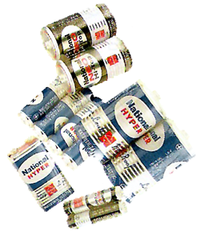
Photo from wikipedia
Aqueous zinc batteries (ZIBs) have attracted considerable attention in recent years because of their high safety and eco-friendly features. Numerous studies have shown that adding Mn2+ salts to ZnSO4 electrolytes… Click to show full abstract
Aqueous zinc batteries (ZIBs) have attracted considerable attention in recent years because of their high safety and eco-friendly features. Numerous studies have shown that adding Mn2+ salts to ZnSO4 electrolytes enhanced overall energy densities and extended the cycling life of Zn/MnO2 batteries. It is commonly believed that Mn2+ additives in the electrolyte inhibit the dissolution of MnO2 cathode. To better understand the role of Mn2+ electrolyte additives, the ZIB using a Co3 O4 cathode instead of MnO2 in 0.3 m MnSO4 + 3 m ZnSO4 electrolyte is built to avoid interference from MnO2 cathode. As expected, the Zn/Co3 O4 battery exhibits electrochemical characteristics nearly identical to those of Zn/MnO2 batteries. Operando synchrotron X-ray diffraction (XRD), ex situ X-ray absorption spectroscopy (XAS), and electrochemical analyses are carried out to determine the reaction mechanism and pathway. This work demonstrates that the electrochemical reaction occurring at cathode involves a reversible Mn2+ /MnO2 deposition/dissolution process, while a chemical reaction of Zn2+ /Zn4 SO4 (OH)6 ∙5H2 O deposition/dissolution is involved during part of the charge/discharge cycle due to the change in the electrolyte environment. The reversible Zn2+ /Zn4 SO4 (OH)6 ∙5H2 O reaction contributes no capacity and lowers the diffusion kinetics of the Mn2+ /MnO2 reaction, which prevents the operation of ZIBs at high current densities.
Journal Title: Small
Year Published: 2023
Link to full text (if available)
Share on Social Media: Sign Up to like & get
recommendations!